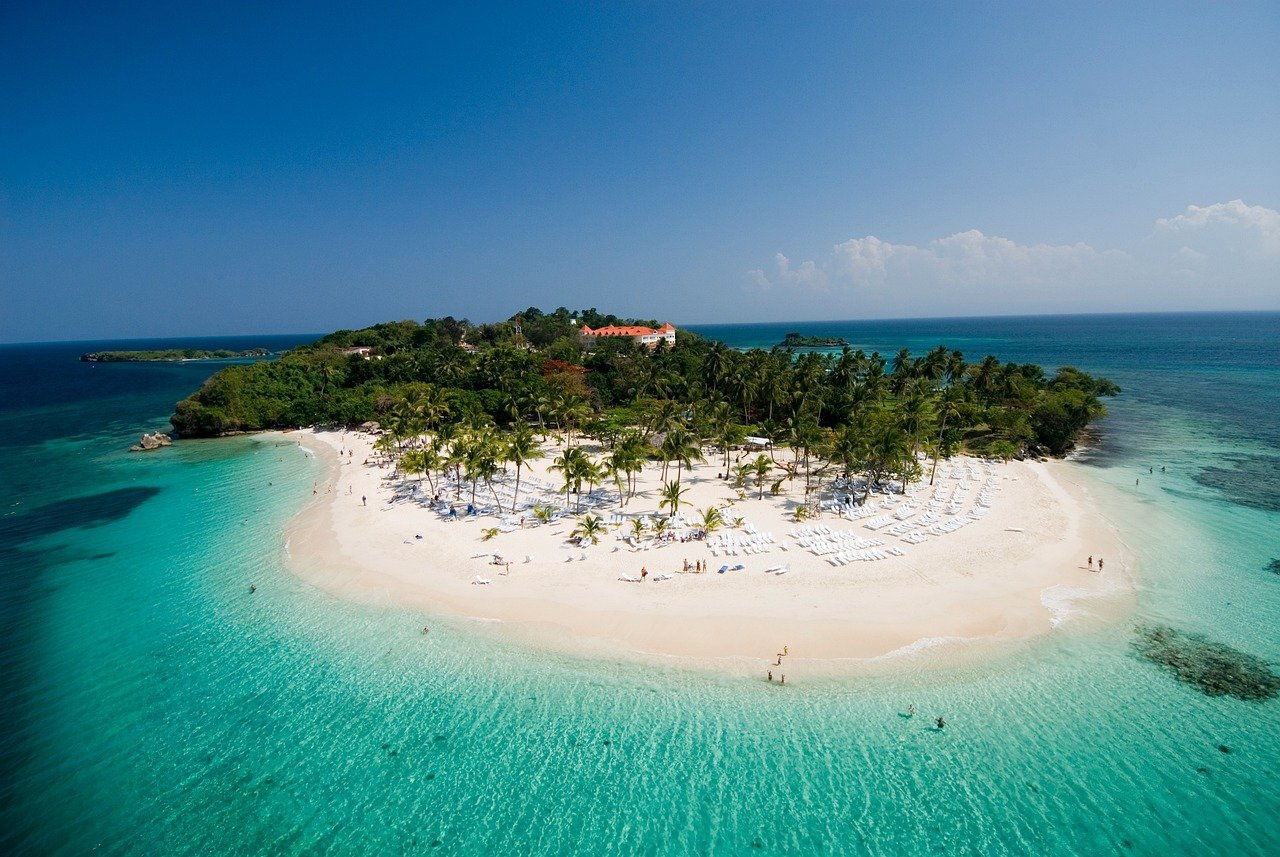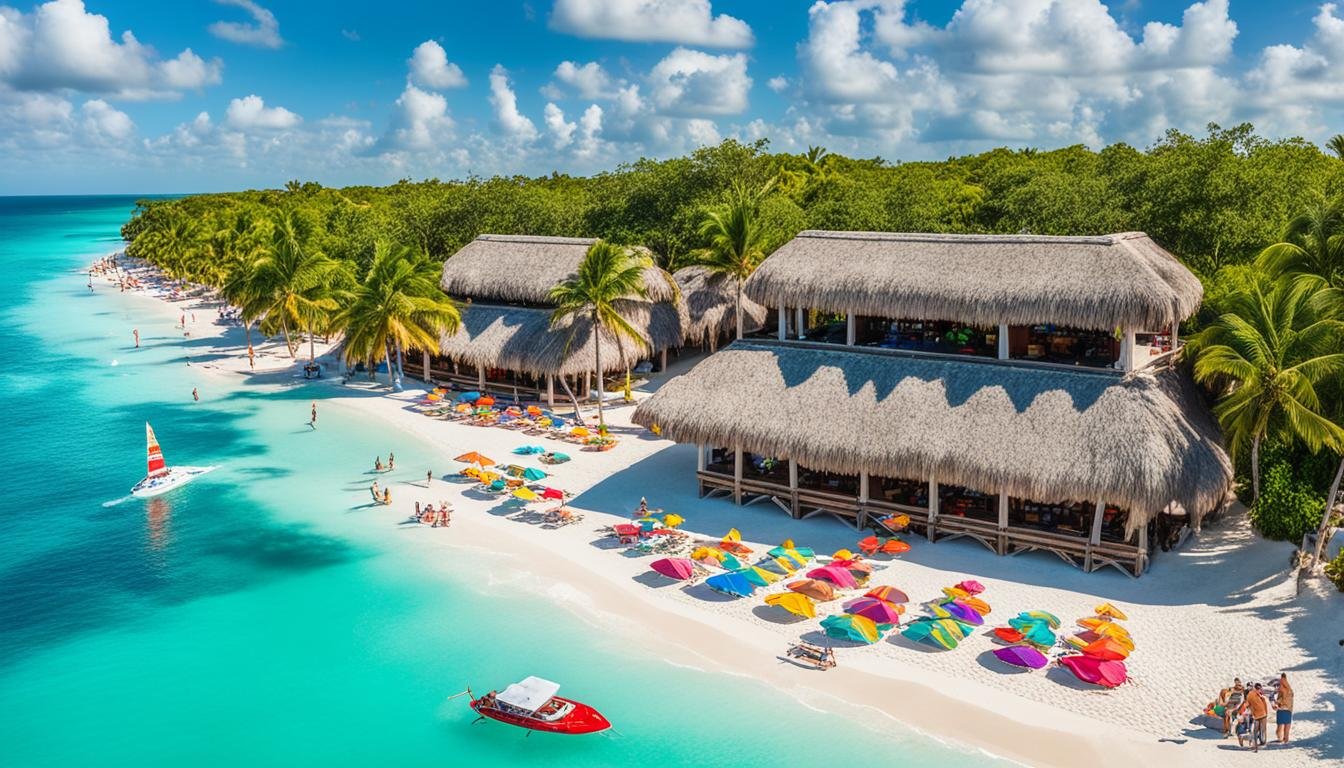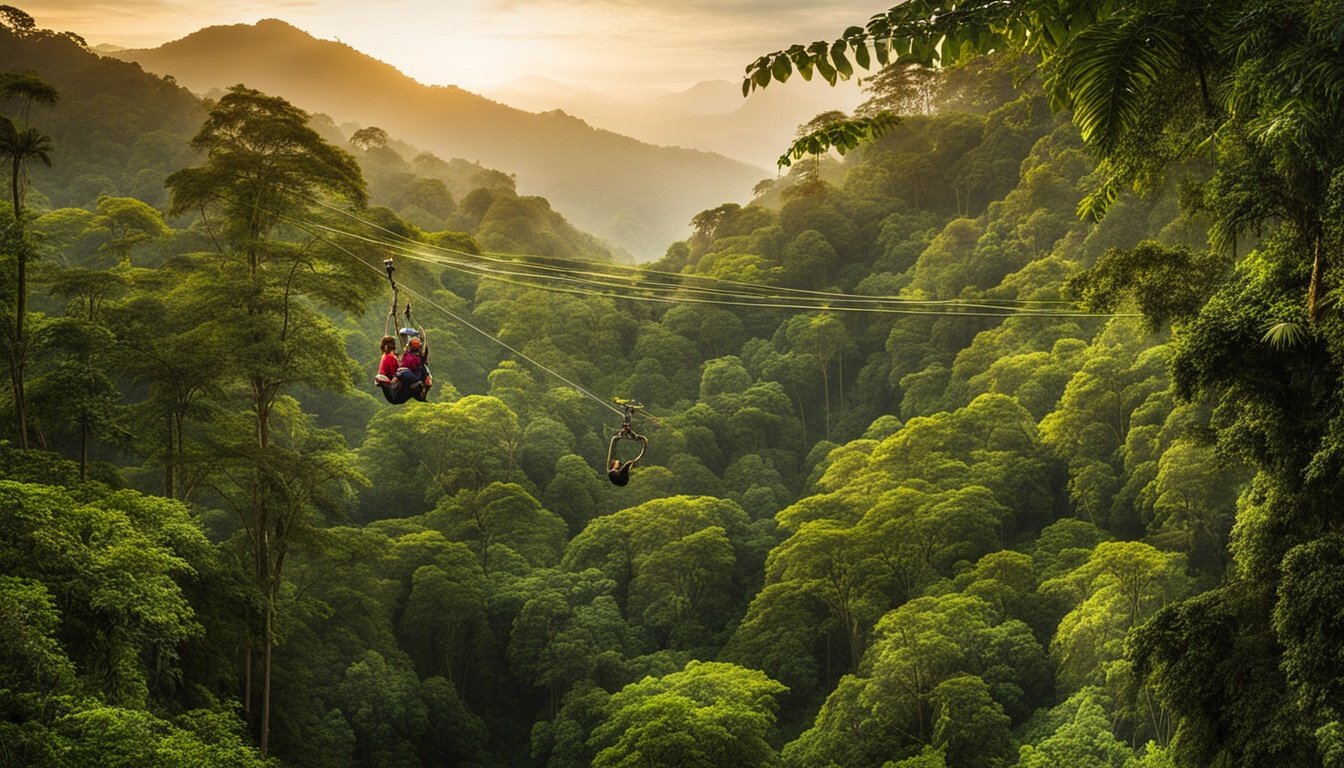
As I step off the plane, I feel a rush of excitement. This is my first time in Costa Rica, and I’m ready for an adventure. With its lush rainforests and stunning beaches, I’ve always wanted to visit.
Costa Rica is a top spot for ecotourism and adventure. It’s a small country in Central America that’s full of life. With 26% of its land protected in national parks, it’s a place where nature and adventure meet.
Key Takeaways
- Costa Rica receives around 3 million international travelers each year, making it a popular tourist destination.
- The tourism sector contributes 12.5% of the country’s GDP, surpassing the economic impact of coffee and bananas.
- 26% of Costa Rica’s land is protected in national parks and reserves, making it a leader in ecotourism.
- Costa Rica is home to a diverse range of wildlife, with around 6% of the world’s biodiversity found within its borders.
- Travelers can experience a wide variety of adventures, from relaxing beach vacations to adrenaline-pumping activities.
Introduction to Costa Rica as a Travel Destination
Costa Rica is a lush, jungle paradise full of natural beauty and wildlife. It stretches from the Caribbean Sea to the Pacific Ocean. This Central American gem is a top spot for travelers of all kinds.
It’s a leader in ecotourism, with over 26% of its land in national parks and reserves. This makes it perfect for those wanting to dive into the natural beauty of Costa Rica and biodiversity.
Costa Rica has towering volcanoes, lush jungles, and beaches with a warm cinnamon color. It’s a dream spot for adventure lovers and nature fans. The country is known for its green efforts and is a top ecotourism spot. Visitors can see its amazing biodiversity up close.
| Key Facts about Costa Rica | Statistics |
|---|---|
| Biodiversity | Costa Rica covers only 0.03 percent of the globe but hosts a remarkable 5 percent of the world’s biodiversity. |
| Protected Land | Over 25% of Costa Rica’s territory remains in a wild state with rainforests, dry tropical forests, and savannas. |
| Bird Population | Arenal Volcano National Park in the Northern Plains region boasts 75% of Costa Rica’s bird population. |
| Coastline | Costa Rica has beaches both in the Caribbean Sea and the Pacific Ocean. |

For more information about this destination please click on this link
Costa Rica is perfect for adventure, relaxation, or connecting with nature. It’s a top travel destination with stunning natural beauty and biodiversity. With its focus on sustainable tourism, it’s a must-see for anyone wanting an amazing ecotourism experience.
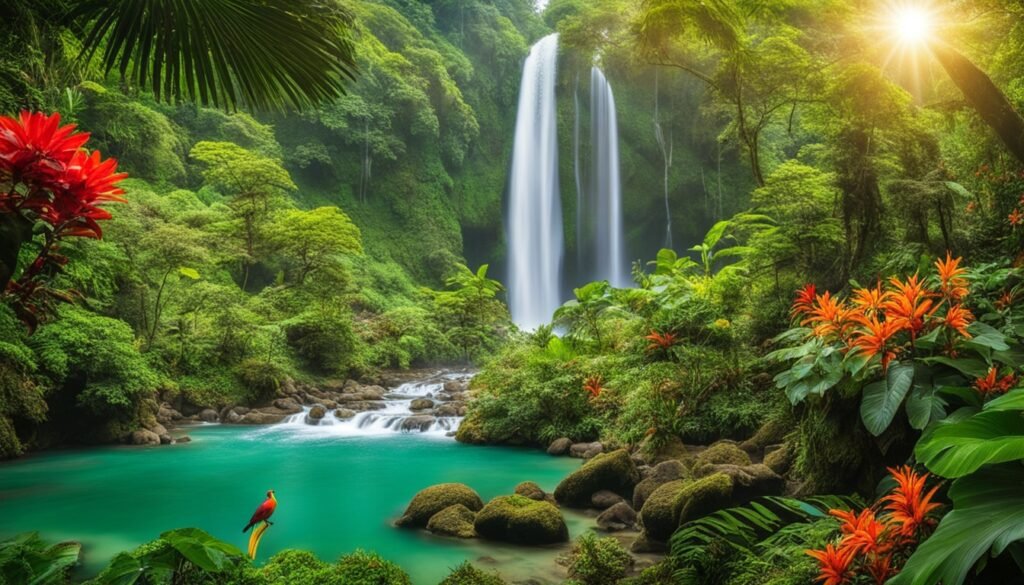
A Brief History of Costa Rica
Colonial Roots and Independence
Christopher Columbus arrived in 1502 and claimed Costa Rica for Spain. For three centuries, it was a Spanish colony, known as the poorest in America. Many indigenous people died from diseases like measles and smallpox.
On October 29, 1821, Costa Rica gained independence from Spain. It joined the Mexican Empire until 1823. By 1869, it had a democratic government but faced economic issues like debt and trade problems.
The 1949 Constitution and Ecological Focus
The 1948 civil war lasted 44 days and killed 2,000 people. After the war, the government ended the military and made a new constitution in 1949. This constitution aimed to make Costa Rica an ecological leader.
Today, Costa Rica is known for its green efforts. It’s ranked 5th globally and 1st in the Americas for environmental performance. The goal is to be carbon-neutral by 2021. This shows the lasting effect of the 1949 constitution and Costa Rica’s commitment to nature.
| Key Milestones in Costa Rica’s History | Year |
|---|---|
| Christopher Columbus first visited Costa Rica | 1503 |
| Costa Rica remained a Spanish colony for about 300 years | 1502-1821 |
| Costa Rica declared independence from Spain | 1821 |
| Costa Rica became part of the independent Mexican Empire | 1821-1823 |
| Costa Rica established a democratic government | 1869 |
| Costa Rican Civil War took place | 1948 |
| Costa Rica abolished its military and established a new constitution | 1949 |
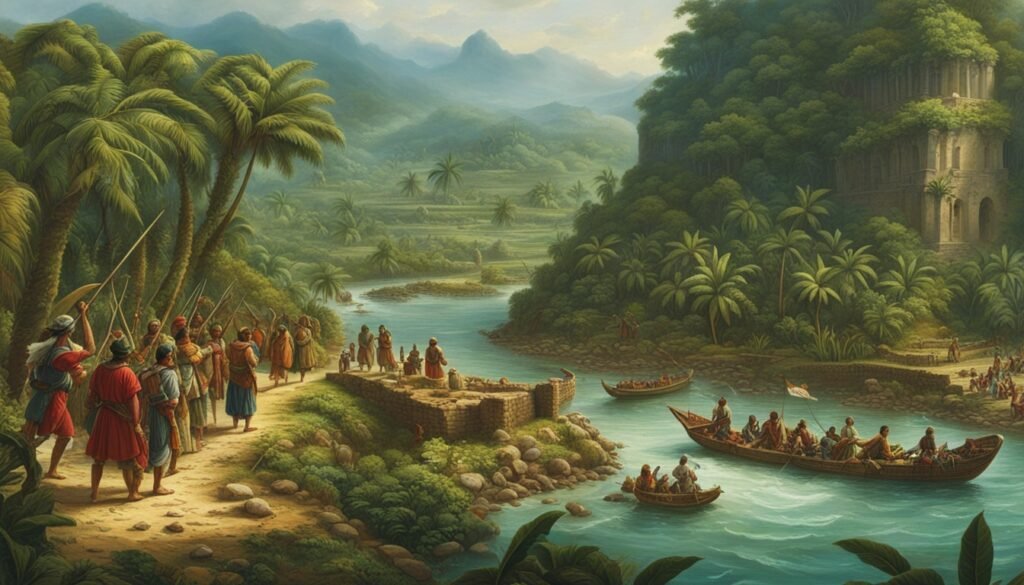
Getting to Costa Rica
Traveling to Costa Rica is easy. You can fly in or drive on the scenic Pan-American Highway. Most people fly into two main airports: Juan Santamaría International Airport (SJO) in San José and Liberia Guanacaste Airport (LIR) in the northern Guanacaste region.
Nonstop flights from major U.S. cities like Los Angeles, Miami, and Orlando are common. Airlines such as American, Delta, JetBlue, and United offer regular flights. Low-cost carriers like Frontier, Southwest, and Spirit also fly here. Round-trip tickets cost between $200 and $500, with higher prices in the dry season (December-April).
If you prefer to drive, the Pan-American Highway goes through Costa Rica. It’s known as the “Vía Muerta” or “Way of the Dead” because of its tough, winding roads. But, it’s a great way to see the country’s beautiful scenery and diverse landscapes.
| Airport | Location | Major U.S. Gateways |
|---|---|---|
| Juan Santamaría International Airport (SJO) | San José | Los Angeles, Miami, New York, Washington D.C. |
| Liberia Guanacaste Airport (LIR) | Liberia | Houston, Chicago, Dallas, Denver |
No matter how you arrive, Costa Rica welcomes you with open arms and stunning natural beauty. With easy transport options and lots to see, your trip to this Central American gem will be unforgettable.

Travel Costa Rica: Getting Around
Exploring Costa Rica is a big part of the adventure. You can travel on a budget or choose luxury, depending on what you like. The country has many ways to get around, like buses, rental cars, and private shuttles. Each option lets you see Costa Rica in a way that fits your style.
Buses in Costa Rica
Buses are a great and cheap way to travel in Costa Rica. Prices start at $2 and go up to $20, based on how far you’re going. They cover most big places, making them perfect for those watching their wallets. But, you might have to wait a bit at stops in small towns.
Rental Cars in Costa Rica
Choosing a rental car lets you see Costa Rica at your own speed. You can find big rental companies near San José and Liberia airports. They offer cars and 4WDs for the tough terrain. Prices start at $40 a day for a regular car and can go up to $80 for a 4WD SUV, with insurance included.
Private Shuttles in Costa Rica
Private shuttles are a quicker and more comfy way to travel. They can take 1-8 people and cost between $50 to $120, depending on where you’re going. These shuttles take you right to your door, making them great for those who want a smooth trip.
Costa Rica has transport options for everyone and every budget. You can travel by bus, car, or shuttle. Each way has its perks and lets you see the beauty and culture of Costa Rica.
| Transportation Option | Cost Range | Key Considerations |
|---|---|---|
| Buses | $2 – $20 | Affordable but slower due to stops in small villages |
| Rental Cars | $40 – $80 per day | Flexible, but 4WD may be necessary for remote locations |
| Private Shuttles | $50 – $120 | Faster and more comfortable, with door-to-door service |
Best Time to Visit Costa Rica
Dry Season vs. Rainy Season
Planning your trip to Costa Rica depends on what you want to do and see. The country has two main seasons: the dry season from December to April and the rainy season from May to November.
The dry season is when most tourists come to Costa Rica. You’ll find sunny skies, low humidity, and little rain. This makes it perfect for beach trips and seeing wildlife. January, February, and March are the best months for sunny weather, especially in Guanacaste.
The rainy season, or “green season,” brings lots of rain, green landscapes, and fewer people. It’s great for those who love nature, bird watching, and surfing. The Caribbean coast rains all year, but the rainy season hits hardest from February to April.
So, the best time to visit Costa Rica depends on what you like. The dry season is best for beach lovers and wildlife fans. The rainy season offers good deals, fewer crowds, and a chance to see Costa Rica’s green beauty. No matter when you go, Costa Rica is a great place to visit all year.
| Season | Months | Characteristics | Ideal For |
|---|---|---|---|
| Dry Season | December – April | Sunny skies, low humidity, less rainfall | Beach vacations, wildlife spotting |
| Rainy Season | May – November | Daily downpours, lush landscapes, smaller crowds | Ecotourism, surfing, birding |

For more information about this destination please click on this link
Top Destinations in Costa Rica
Costa Rica’s seven provinces offer a wide range of best places to visit in costa rica and top attractions in costa rica. From the lively capital to the distant Osa Peninsula, there’s something for everyone. Discover the popular destinations in costa rica and must-see spots in costa rica to truly experience this Central American gem.
San José, the capital, is a mix of modern and colonial styles. It’s full of cultural spots like the National Museum of Costa Rica and the Jade Museum. You can also find great souvenirs here.
Alajuela province is perfect for thrill-seekers. Hike the Arenal Volcano or zip line through the trees. Limón province offers a taste of Afro-Caribbean culture and is great for turtle watching in Tortuguero National Park.
- Check out Guanacaste’s Pacific beaches for clear waters and great surfing.
- Visit Monteverde’s cloud forests, where you’ll find over 3,000 plant and animal species.
- Head to the Osa Peninsula for the Corcovado National Park’s incredible wildlife.
Every top destination in costa rica you visit will amaze you with its nature, culture, and friendly people. Get ready for an unforgettable trip to this amazing place.
Here are five top hotel resorts in Costa Rica:
- Four Seasons Resort Costa Rica at Peninsula Papagayo
- Andaz Costa Rica Resort at Peninsula Papagayo
- Nayara Springs
- The Springs Resort and Spa
- Lapa Rios Lodge
Essential Costa Rica Travel Tips
Safety and Precautions
Exploring Costa Rica’s beauty and culture means keeping safety in mind. It’s important to take some precautions for a safe trip.
Always be careful against petty crime, especially in San José. Keep your valuables safe and don’t walk alone in dark places at night. In other parts of the country, lock up your things, be careful with public transport, and watch your belongings.
Learning some basic Spanish before you go is a smart move. It helps you talk to locals and can make shopping better. Also, having cash is a must since not all places take credit cards in Costa Rica.
| Safety Tip | Recommendation |
|---|---|
| Petty Crime | Keep valuables secure, avoid isolated areas at night in San José |
| Public Transportation | Be cautious, keep an eye on your surroundings |
| Language | Learn some basic Spanish phrases before your trip |
| Currency | Carry cash, as credit cards are not widely accepted |
Follow these costa rica travel tips and stay alert to have a safe and memorable trip. Enjoy your travels!
Sustainable Tourism in Costa Rica
Costa Rica leads the way in sustainable travel. It protects over a quarter of its land in national parks and reserves. This shows its strong commitment to the environment and renewable energy. Visitors can dive into this by staying at eco-lodges, joining nature tours, and enjoying activities like hiking and birdwatching.
By 2019, Costa Rica had certified over 400 companies for their green practices. From sunny Guanacaste beaches to lush cloud forests, there are many ways to explore nature. These activities help support the country’s green efforts.
For example, Cala Luna Boutique Hotel sits on a 74-acre farm in Tamarindo. El Silencio Lodge & Spa is in a 500-acre cloud forest reserve in Bajos Del Toro. Finca Rosa Blanca, a coffee farm and inn, has been a leader in regenerative tourism for over 30 years. It has planted over 5,000 native trees and coffee fields.
Companies like ARA Tours and Horizontes Nature Tours are also making a difference. ARA Tours won a Carbon Neutrality Plus Award. Horizontes Nature Tours has been certified for 16 years in a row.
Visiting Costa Rica responsibly helps the country protect its amazing nature and wildlife. It also supports thriving Indigenous communities in tourism. Costa Rica offers a unique chance to travel sustainably.
| Sustainable Tourism Initiatives in Costa Rica | Key Facts |
|---|---|
| Certification for Sustainable Tourism (CST) Program | Over 400 companies certified as of 2019 |
| Regenerative Tourism | Cala Luna Boutique Hotel, El Silencio Lodge & Spa, Finca Rosa Blanca |
| Sustainable Tourism Awards | ARA Tours: Carbon Neutrality Plus Award, Horizontes Nature Tours: 16 consecutive years of CST certification |
| Indigenous Community Tourism | Bribri community in Yorkin, cultural exchanges and traditional activities |
| Conservation and Reforestation Efforts | 33% of land preserved, increase in green areas from 25% to 56% |
Vacation Must-Haves
Before You Go… Luggages / Scales / Passport / Books
During The Flight… Pillows / Masks / Noise Cancelling
At The Beach… Sunscreen / Hats / Sunglasses / Insulated Mugs
In Excursion… Water Shoes / Mosquitoes / Water Bottles
Evening… Dresses / Jewels / Shoes
Conclusion
Reflecting on my journey in Costa Rica fills me with wonder and appreciation. This place has left a lasting mark on my heart and mind. It’s full of lush rainforests and beautiful beaches, offering unique experiences for travelers.
Costa Rica stands out for its focus on sustainability and protecting nature. Over 20% of its land is in national parks and reserves. This shows its commitment to responsible tourism. The country’s variety of ecosystems support a wide range of life, from the quetzal bird to playful howler monkeys.
As I say goodbye to Costa Rica, I feel grateful and eager to come back. This place has inspired me to travel more thoughtfully and sustainably. With this guide, I’m sure others will find their way to this amazing spot. Here, adventure and nature’s beauty are waiting to be discovered.
Related Links
https://www.visitcostarica.com/en
https://en.wikipedia.org/wiki/Costa_Rica
https://www.britannica.com/place/Costa-Rica
FAQ
What makes Costa Rica a unique travel destination?
What are the best ways to get to Costa Rica?
How can I get around Costa Rica once I’ve arrived?
When is the best time of year to visit Costa Rica?
What are some of the top destinations and activities in Costa Rica?
What safety precautions should I take when traveling in Costa Rica?
How is Costa Rica leading the way in sustainable tourism?
The Baffls Team (info@baffls.com)
https://baffls.com/category/travel
#DiscoverCostaRica #CostaRicaAdventure #ExploreCostaRica
Permis OPC: 202412351062
Des conditions s’appliquent
DIsponibilités et prix sujet à changement sans préavis
Titulaire d’un permis du Québec
Disclosure: This post contains affiliate links. If you make a purchase through these links, I may earn a commission at no additional cost to you. We only recommend products or services that I personally use and believe will add value to my audience. Your support helps keep this content free for everyone. Thank you for your support!
Prices and discounts noted at the time of publication Saturday August 31, 2024. They may have been changed without notice by the retailer at the time you view this page.

